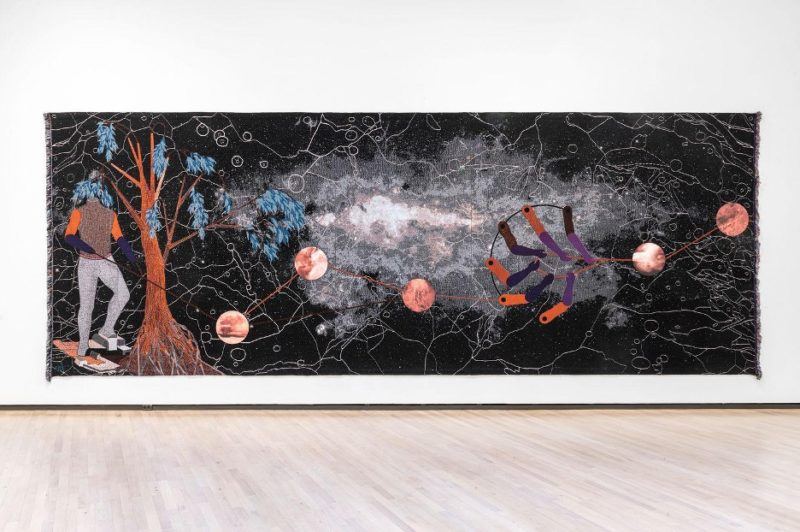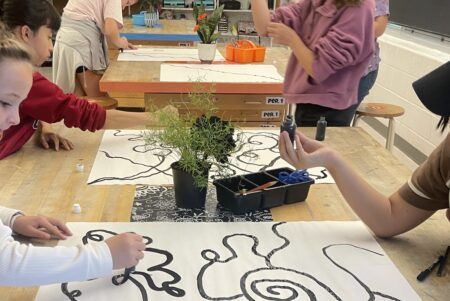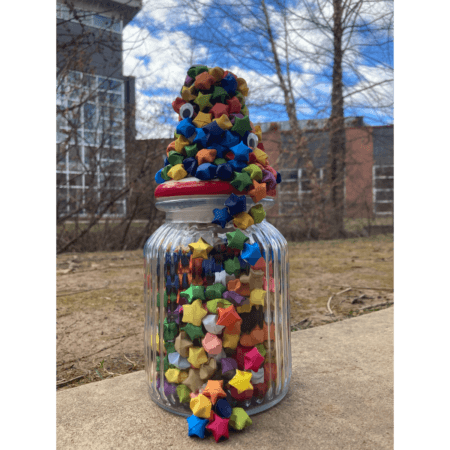Teaching with Contemporary Art
The Art of Connecting

IMAGE: Otobong Nkanga, Double Plot, 2018. Photo by Amiko Matsuo
I am standing in-person at one of my favorite spaces, the Hammer Museum in Los Angeles, for the first time in at least two years. First, there was the pandemic, and then we moved to the Pacific Northwest. My young daughter snacks outside in the courtyard with my partner as I pause and sit for the first time with Otobong Nkanga’s works. The tightly woven textiles map an aerial landscape, the color range and values, restrict the flattened image in a way that I’m sensitive to — yet my perceptual calibration is off. I often have more difficulty gauging tactile space and textures after too many hours with the computer screen’s strange distortions.
Nkanga’s art weaves multi-vocal stories of colonial histories, the extraction of resources, and the land itself. And it opens a space for linkages between collectivities and lives—it allows us to listen to places and landscapes speak. As I stand near it at The Hammer, I’m feeling the connectivity that the work is advancing. I’m thinking about how the work illuminates the connections to land, minerals, the elements, and the roots, despite how we live without roots in these places.

Otobong Nkanga, Infinite Yield, 2015.
I walk to the larger textile: a map or network layered and woven in the cosmos. The edge of the textile welcomes a figure about to step forward without feet or a brain. It enters the plane on the wall next to urchiny tree branches. Is the figure tethered to circular captions? Is it directing the mechanical arms to pull at the bubble captions? Floating, it feels unmoored even as it appears to be hard at work.
I’m interested in how to translate for learners and students this sense of connectivity and geopolitics that is represented in the work. My own voice as an arts educator participates in the witnessing and telling of such stories. I am made aware of the ways that I’m understanding artwork through a lens of who I am right now, and also, of all the people and practices that I am linked to, as one part of an interconnected and rhizomatic network of teachers. I imagine the kinds of collective impact we aspire to as Art21 Educators if we can do this kind of work together.
My personal experiences with contemporary art as a practice of reflection and research initiate the web of connections that I hope to pass on to my students — a sense of interconnectivity, collectivity, and community that has been extended by my Art21 Educators experience. Before I can start to share the specifics of module materials, assignments, and student works, my teaching practice is grounded in the broad web of artistic networks, developed through artworks and artmaking. This collective work both defines me individually and expands far beyond me.

Otobong Nkanga, The Leftovers, 2017.
It’s only in the last few years that I’ve really been able to see my teaching as collective work, a shift largely due to my small group of Art21 Educators cohort. We are Dennis and Ty, mentors and alumni of the Art21 Educators program, Debra, Chris, Amy, and I, and we are instructors working across the United States in different contexts. Dennis, Ty, and I live and work in Seattle, where I moved during the pandemic; Debra’s school is in Richmond, CA; Amy works in Roanoke, VA; and Chris in New York.
When we met in the summer of 2021, we were all stretched to the breaking point like gluten-y dough. The Summer Institute and monthly meetings were all virtual until this summer. I thought making connections virtually would be challenging as it was when we moved to virtual instruction in 2020. But we made it work. We cried, read, laughed, raged, made art, told stories, ruminated, grieved, looked at art, and met artists together. We also celebrated and congratulated one another. We shared joy and care during a time when my capacity felt more limited than ever before.
Nkanga’s work reminds me that the tapestry we create in education is multivocal, woven together, and interconnected. We work in a field that exists in systems that are in constant need of contestation and advocacy for our students and the communities we serve. In the present moment, our pedagogical decisions have socio-ecological repercussions; we need care, love and hope.



